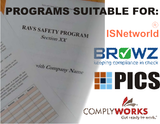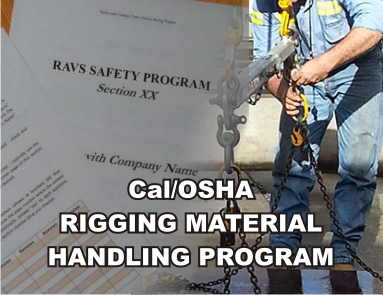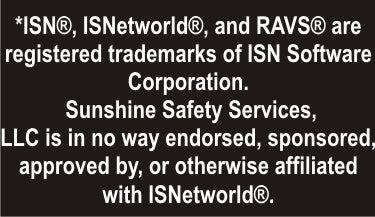Cal/OSHA Rigging Material Handling Program - ISNetworld RAVS Section - US
$ 29.95
Cal/OSHA Rigging Material Handling Program - ISNetworld RAVS Section - US
 This Cal/OSHA Rigging Material Handling Program (ISNetworld® RAVS®* Section), in addition to being a complete and functioning written safety program (chapter), it also contains all the required text elements that are sought by the ISNetworld RAVS® (Review And Verification Service) reviewer. This plan has been previously submitted and has achieved a 100% approval rating for our clients.
This Cal/OSHA Rigging Material Handling Program (ISNetworld® RAVS®* Section), in addition to being a complete and functioning written safety program (chapter), it also contains all the required text elements that are sought by the ISNetworld RAVS® (Review And Verification Service) reviewer. This plan has been previously submitted and has achieved a 100% approval rating for our clients.
- All programs are guaranteed now and in the future to achieve 100% approval.
- There are NO maintenance or subscription fees.
- Simply notify us if any program falls out of compliance and we will correct it at NO CHARGE.
You are downloading a MicroSoft® Word document file to your computer that is completely editable:
- Cal/OSHA Rigging Material Handling Program:
- Approximate Word Count: 4,450
- Approximate Number of Pages: 15
- Page Reference Answers to RAVS Reviewer’s Questions: 8
You will also receive instructions for a simple two-step process to place your company name and safety person's name throughout this word document to conform it to your company. Please review, and feel free to alter or add to it as you wish with any specific company information or safety policies that you may already have.
The first two pages of the document are guidelines for conforming this safety manual section, an index for completing the RAVS® questionnaire (with all page references), and uploading the section.
If you experience any difficulty filling out the questionnaire, or have any questions in general about these documents, call 314-698-7915, or e-mail me at vsunshine1@gmail.com.
An excerpt from ISNetworld® RAVS®* Safety plan Cal/OSHA Rigging Material Handling Program
Planning for safe rigging and lifting must begin at the design stage, and lifting procedures must be developed for assembly and installation. The lifting procedure should be developed and discussed with the rigging crew supervisor.
Riggers are responsible for final rigging and for carrying out whatever moves have been designated. The supervisor must make certain that personnel know how to move objects safely by hand or with mechanical devices in the operations normal to the area and must permit only those employees who are formally qualified by training and certification to operate a fork truck, crane, or hoist. The supervisor must enforce the use of safe lifting techniques and maintain lifting equipment in good mechanical condition.
Employees are required to observe all established safety regulations relating to safe lifting techniques. All employees shall be kept clear of loads about to be lifted and of suspended loads.
The Responsible Safety Officer provides training programs followed by certification for employees who have demonstrated the ability to operate fork trucks of up to 4-ton capacity and for incidental crane operations that require no special rigging.
The Operator/Rigger Training Program is administered by the RSO, Replace with Safety Person’s Name, or designated person. The training staff consists of a qualified crane consultant, professional riggers, and the Responsible Safety Officer. There are two levels of required training and performance:
Professional Operator/Rigger: Person whose principal assignment includes crane operation and rigging functions. The chief operator/rigger must ensure that those professional operator/riggers under his/her supervision maintain the necessary qualifications.
Incidental Operator/Rigger: Person who performs operating/rigging functions as an incidental part of his/her normal work assignment. Persons in this category are restricted to lower load limits and rigging of specific types of hardware.





